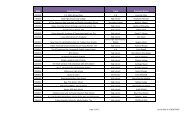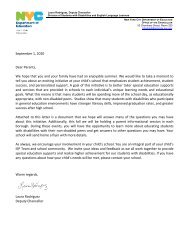Predicting language outcome in infants with autism and pervasive ...
Predicting language outcome in infants with autism and pervasive ...
Predicting language outcome in infants with autism and pervasive ...
You also want an ePaper? Increase the reach of your titles
YUMPU automatically turns print PDFs into web optimized ePapers that Google loves.
<strong>Predict<strong>in</strong>g</strong> <strong>language</strong> <strong>outcome</strong> <strong>in</strong> <strong>in</strong>fants <strong>with</strong> <strong>autism</strong> 273Longitud<strong>in</strong>al associations between diagnosis <strong>and</strong> performance on the experimentalmeasures at 20 months <strong>and</strong> <strong>language</strong> <strong>outcome</strong> at 42 monthsTable 2 shows the <strong>language</strong> <strong>outcome</strong> at age 42 months <strong>in</strong> terms of raw RL <strong>and</strong> ELReynell-DLS scores for the sample divided by diagnosis (<strong>autism</strong> versus PDD) <strong>and</strong>low versus high NVIQ <strong>and</strong> low versus high performance on the experimentalmeasures at age 20 months. Non-parametric Mann–Whitney U-tests were conducted,correct<strong>in</strong>g for tied ranks. Both RL <strong>and</strong> EL were significantly higher at 42 monthsfor the children <strong>with</strong> PDD compared <strong>with</strong> the children <strong>with</strong> <strong>autism</strong> ( p




